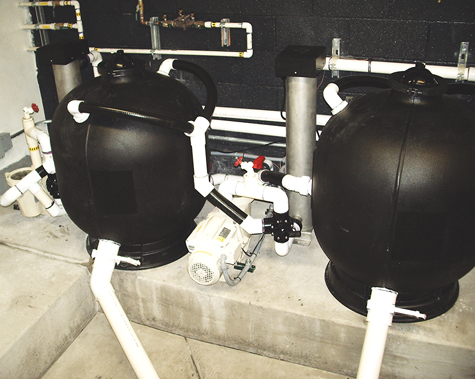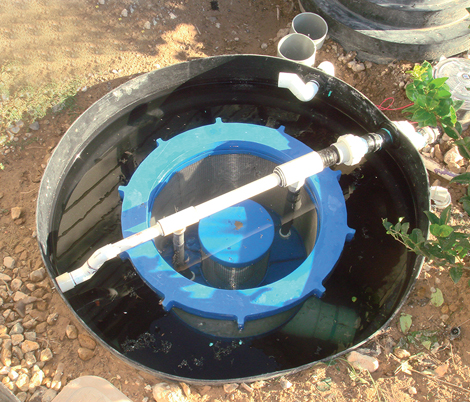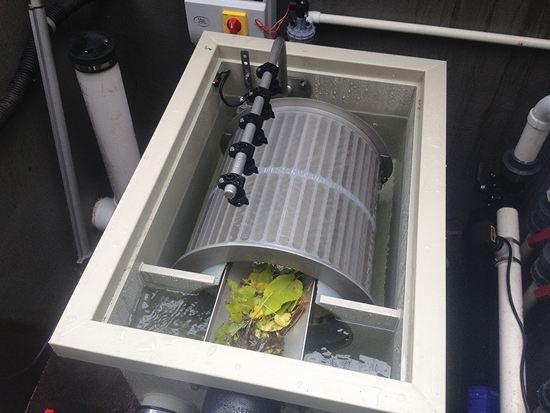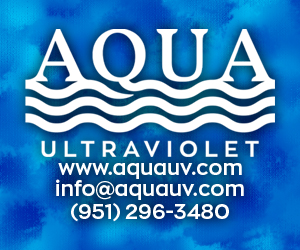Living water features produce solids from fish wastes, food, dirt, leaves, algae and other environmental conditions. Removing these solids from the water column before the pump or biofiltration has become an important part of a complete filtration system. The methods of removing solid wastes are known as prefiltration and the techniques that are used have gone through several phases in recent years.
What Are We Filtering?
Solids come in three basic categories: floating solids, sinking solids and neutrally buoyant solids. Knowing how to deal with each type can be a useful tool when designing a pond from scratch or retrofitting an existing pond.
In its most basic form, any pump leaf trap or screen over a pump’s intake is a prefilter. While these basic prefilters are always necessary for the protection of the pump’s impeller, they are not adequate for removing the types of solids that can clog a biofilter or cloud the pond’s water. Even trapping-type “plug flow” biofilters are more efficient when the water flowing through them has had the larger and heavier solids removed first. Biofilter maintenance is much easier and less frequent when the heavier solids have been removed.

Floating solids are removed from the pond surface and upper layers of pond water with a skimmer. Skimmers can have just a leaf trap basket or, as discussed in previous articles, contain pads, matting or brushes to trap debris in a second stage before the pump.
Sinking solids are heavier than water and are removed from the pond by removing water from the bottom of the pond. Bottom-grid systems are popular but traditionally difficult to manage and clean. As shown in previous articles, Eric Triplett at The Pond Digger has helped reform bottom-grid systems by making them backflushable and aerated. In-pond, backflushable, bottom-grid systems are both mechanical prefiltration and biofiltration.
Settle Down!
When moving to completely external systems, bottom drains have become the standard method of exit for sinking solids over the last couple of decades. A bottom drain is usually connected directly to a prefilter with the pump after it. In some gravity-flow systems the pump is located after the biofilter. The early prefilters were simple settlement tanks which created a “wide” space in the water flow that slowed the speed of the water down. This allows particles heavier than water to fall out of suspension and sink to the bottom as the water passes slowly through the chamber. The cleaner water is then removed from the top of the water at the far end and the heavier debris is flushed off the bottom to drainage. Dwell time is the length of time it takes to pass through the chamber from inlet to outlet, and settlement chambers were traditionally large — in some instances, they were up to 10 percent of total pond volume. Early settlement chambers required a lot of room to allow enough dwell time for the particles to fall from suspension, and when large enough some of the more neutrally buoyant particles can also be settled out.
With space being a serious commodity in pond construction, more efficient round vortex settlement chambers with a much smaller footprint came into use. Pond water enters the tank at a tangent low in the tank’s side and rotates within the tank, with centrifugal forces acting on particles to help them settle out. The inlets are usually in the bottom third of the tank’s height, and as the cleaner water rises it is then pulled off at the top by the pump or flows with gravity to the next chamber through an outlet. An outlet screen prevents larger, neutrally buoyant particles or small fish from transferring to the next tank or pump. These tanks can be flat-bottomed or cone-bottomed, with the cone shape helping to concentrate the debris near the drain for easier removal. The slow, rotating motion created in a vortex tank makes the path from inlet to outlet very long, increasing dwell time.Floating Micro-Screens
The outlet screens on settlement chambers are a source of regular maintenance, so the next stage of prefiltration was an additional mechanical prefilter located on the outlet pipe to pull even smaller particles from the water column. A floating micro-screen is a barrel-shaped, stainless steel screen that floats around a center-mounted outlet pipe. The smaller particles are screened out as the water passes through, while spray bars on the inside of the screen spray outward through the screen in a self-cleaning mode as the assembly rotates with the water flow. As the smaller, neutrally buoyant particles that made it through the bottom drain collect on the outside of the screen, they are constantly being blown off by the spray bars, getting another chance to eventually settle out. The spray bars require approximately 1,000 gallons per hour of pump flow to operate.

The floating micro-screen system doesn’t work quite as well for prefiltration in a gravity-flow skimmer or mid-water circuit, though. These circuits deal with floating and neutrally buoyant solids only. When used with a floating micro-screen the tank looks like a soup of floating debris. Few of these particles settle out, and eliminating them from the tank is time-consuming and difficult.
A trapping-type prefilter is better suited for this application. These prefilters can be made with a basket that fits inside of the chamber on the same center pipe location as the floating micro-screen and are filled with a static trapping media. The Helix prefilter uses this type of technology. Static prefilters get cleaned by placing a tee off of the line from the center pipe exit to the pump or next chamber and valving it to drainage or by emptying the tank. The media gets disrupted with either an air ring or by shaking, releasing the debris to drainage. Trapping filters have a smaller dwell time consideration when it comes to the tank they are located in and can consequently use smaller tanks. To date, Bacti-Twist is my favorite media for static trapping.
[box]Series | Best Pond Practices: This is an installment of an ongoing, monthly series. Read last month’s article, “Fractal Plumbing for Pond Circulation Management.”[/box]
It’s also important to note that secondary prefilters located in a tank should be easily removable so that removing a fish or other large item of debris trapped in the primary tank can be facilitated easily. Both floating micro-screens and static prefiltration baskets can be easily removed in seconds for convenient tank maintenance.
Radial Separators
Another type of settlement tank is a radial separator. These are largely used in aquaculture but rarely used in koi ponds only because they need a constant water level with little or no fluctuation. In a pond the water level goes up and down slightly over time, even with an auto-fill. Radial separators are a tank within a tank. The pond water enters through the side of the outer tank and through to an inner chamber with an open top and bottom. As the water enters the inner chamber it travels downward and out the bottom, where it reverses its direction and travels back upward between the outer and inner chamber. The outer chamber is larger in diameter than the inner chamber and has more total volume. This flow reversal slows the water down in a shearing effect, causing the heavier particles to fall to the bottom as the cleaner water rises to the top. The outlet is a radial ring with a corrugated edge forcing the water to flow evenly into the perimeter trough. Living Water Solutions is currently working on a radial separator that will allow 4 to 5 inches of water level change, making its more applicable to outdoor ponds.

Rotary drum filters or RDFs are another form of gravity-flow prefilter. Like a floating micro-screen, an RDF uses a rotating stainless steel barrel screen to separate out the particles. Unlike a floating micro-screen, the screen’s barrel is mounted horizontally instead of vertically and it does not float or rotate in real time with the water flow. Water enters the inside of the barrel and flows through the screen into an outer chamber where it exits to the pump or biofilter filter. The screen barrel sits half-in and half-out of the water in the outer chamber, and as the screen gets restricted with debris from the inside, a water level sensor in the outer chamber detects the change in water level. As the water level in the outer chamber lowers, the sensor turns on a set of spray bars as a motor slowly rotates the screen, cleaning the debris off of the screen and depositing it in an exit trough.
Instances arise when a gravity-flow prefilter is not practical because of space constraints. This is mostly apparent in a retrofit or rebuild where hardscape, landscape, plumbing layout or space in general is an issue. In these cases a direct suction prefilter can be used. One type of direct suction prefilter uses an external tank, much like the tank a bead filter uses. The tank can sit above water level with the drain line connected directly to the prefilter. The pump pulls the water through the tank under very little vacuum to allow the use of low-head pond pumps. In a direct suction Static Suction Prefilter, water enters the tank in the center and vortexes as in a settlement tank. The heaviest debris falls to the bottom and the cleaner water passes through a divider plate that separates an upper secondary chamber with Bacti-Twist in it to trap the smaller debris. Regular backflushing cleans the system easily. Other types of direct suction prefilters are being developed, so in the future more choices will become available.
Prefiltration makes the complete system more balanced and stable by improving water clarity and quality and lowering the frequency of biofilter maintenance. When designing a pond, think prefiltration first, biofiltration second and your customers will be much more satisfied with their projects long-term.


